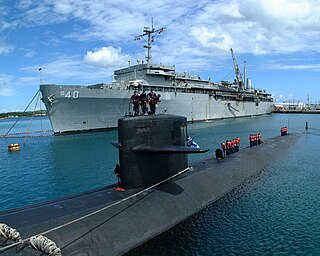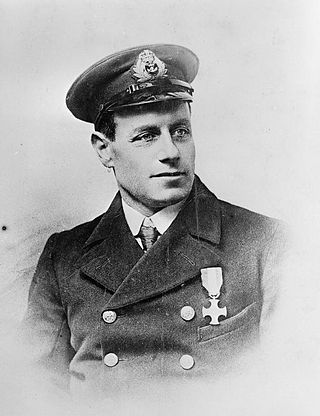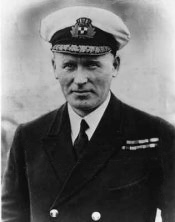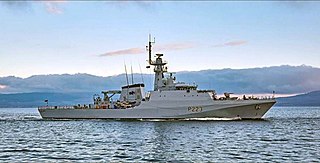
A submarine tender, in British English a submarine depot ship, is a type of depot ship that supplies and supports submarines.

HMS Chatham was a Batch 3 Type 22 frigate of the British Royal Navy. She was decommissioned on 8 February 2011.

The PS Medway Queen is a paddle driven steamship, the only mobile estuary paddle steamer left in the United Kingdom. She was one of the "little ships of Dunkirk", making a record seven trips and rescuing 7,000 men in the evacuation of Dunkirk.

Thomas Crisp VC, DSC, RNR was an English sailor and posthumous recipient of the Victoria Cross. Crisp, in civilian life a commercial fisherman operating from Lowestoft in Suffolk, earned his award after being killed during the defence of his vessel, the armed naval smack Nelson, in the North Sea against an attack from a German submarine in 1917.
MV Princess Victoria was one of the earliest roll-on/roll-off ferries. Completed in 1947, she operated from Stranraer, Scotland, to Larne, Northern Ireland, initially by the London, Midland and Scottish Railway (LMS) until 1 January 1948 and thereafter by LMS's successor British Railways. During a severe European windstorm on 31 January 1953, she sank in the North Channel with the loss of 135 lives. This was then the deadliest maritime disaster in United Kingdom waters since World War II. For many years it was believed that 133 people had lost their lives in the disaster. However, research by a local historian, Liam Kelly, identified two other victims—Gordon Wright and Thomas Saunders—who had not been identified as there had been no passenger list at the time.

Ronald Niel Stuart, VC, DSO, RD, RNR was a British Merchant Navy commodore and Royal Navy captain who was highly commended following extensive and distinguished service at sea over a period of more than thirty-five years. During World War I he was awarded the Victoria Cross, the Distinguished Service Order, the French Croix de Guerre avec Palmes and the United States' Navy Cross for a series of daring operations he conducted while serving in the Royal Navy against the German U-boat campaign in the Atlantic.

Seafield is a coastal strip situated on the Firth of Forth between Leith and Portobello in north-east Edinburgh, Scotland. The area is mainly commercial, and has little housing.

Rohilla was a passenger steamer of the British India Steam Navigation Company which was built for service between the UK and India, and as a troopship. After becoming a hospital ship in the First World War, She ran aground in October 1914, near Whitby ,And then salvaged out of the water by James Weatherill ,The wreck resulted in the loss of 83 lives.

HMS Shoreham was a Sandown-class minehunter of the British Royal Navy. She was the fifth vessel to bear the name. From 2018 to 2021, Shoreham was deployed at UKNSF Bahrain together with three other mine countermeasures ships as part of 9 Mine Countermeasures Squadron on Operation Kipion. In 2022 she was decommissioned and was transferred to Ukraine.

German submarine U-35 was a Type VIIA U-boat of Nazi Germany's Kriegsmarine. She was built three years before the start of World War II. The submarine was laid down on 2 March 1936 by Friedrich Krupp Germaniawerft at Kiel, launched on 24 September 1936, and commissioned on 3 November that year under the command of Kapitänleutnant (Kptlt.) Klaus Ewerth. The U-boat was featured on the cover of Life magazine on 16 October 1939, for its then commander Werner Lott "courteously" rescuing and putting to shore all the sailors of a Greek ship that U-35 was about to sink.
Abels Shipbuilders Ltd was a ship and boat builder in Bristol, England. In addition to boat building, the company branched out into architectural sculptures, tidal energy and marine restoration, but closed in 2016.

The Little Ships of Dunkirk were about 850 private boats that sailed from Ramsgate in England to Dunkirk in northern France between 26 May and 4 June 1940 as part of Operation Dynamo, helping to rescue more than 336,000 British, French, and other Allied soldiers who were trapped on the beaches at Dunkirk during the Second World War.
The Texel Disaster took place off the Dutch coast on the night of 31 August 1940 and involved the sinking of two Royal Navy destroyers, and damage to a third and a light cruiser. The disaster was caused by a destroyer flotilla running into an unmarked minefield, which caused serious damage to one vessel; two more destroyers were sunk going to the aid of the first, and a light cruiser sent as an escort was slightly damaged by a mine on the return journey. In all, the disaster caused approximately 300 deaths, with a further 100 men injured or taken prisoner of war.

ST Cervia was built in 1946 as a seagoing tug for use as a fleet auxiliary by Alexandra Hall & Company Ltd of Aberdeen, Scotland. Today she is a floating Museum still undergoing restoration in Ramsgate, Kent.

The Net class were a class of boom defence vessels of the Royal Navy and Royal Australian Navy during World War II.

Torbay Lifeboat Station is the base for Royal National Lifeboat Institution (RNLI) search and rescue operations at Brixham, Devon in England. Brixham Lifeboat Station was opened in 1866 but since 1924 has been known as 'Torbay'. Since 2005 it has operated a Severn-class all-weather lifeboat (ALB) together with a D-class (IB1) inshore lifeboat (ILB).

HMS Forth is a Batch 2 River-class offshore patrol vessel in active service with the Royal Navy. Named after the River Forth, she is the first Batch 2 River-class vessel to be built. She was commissioned into the Royal Navy on 13 April 2018, following a commissioning ceremony at her homeport HMNB Portsmouth. In January 2020 she replaced HMS Clyde as the Falkland Islands patrol ship.

HMS Medway is a Batch 2 River-class offshore patrol vessel for the Royal Navy. Named after the River Medway in Kent, she was the second Batch 2 River-class vessel to be commissioned and is assigned long-term as Royal Navy guardship in the Caribbean.
HM Tug Char, formally the North Eastern Railway tug Stranton, was a ship requisitioned by the Admiralty during the Great War.
















